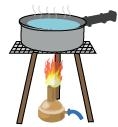Exercise : Solutions of Questions on Page Number : 45
Q1 : State similarities and differences between the laboratory thermometer andthe clinical thermometer.
Answer :
Similarities:
(i) Both clinical and laboratory thermometers have long, narrow, uniform glass tubes.
(ii) The bulbs of both the thermometers have mercury in them.
Differences:
(i) The temperature range of clinical thermometers is from 35°C to 42°C while that of laboratory thermometer is from -10°C to 110°C.
(ii) Clinical thermometer is used to measure the temperature of a human body. However, laboratory thermometer cannot be used to measure the temperature of a human body.
(iii) The least count of both the thermometers differs.
(iv) Unlike clinical thermometer that can be tilted, laboratory thermometer is kept upright while reading the temperature values.
Q2 : Give two examples each of conductors and insulators of heat.
Answer :
Two examples of conductors of heat are:
(i) Aluminium
(ii) Iron
Two examples of insulators of heat are:
(i) Wood
(ii) Plastic
Q3 : Fill in the blanks:
(a) The hotness of an object is determined by its __ __.
(b) Temperature of boiling water cannot be measured by a
____ thermometer.
(c) Temperature is measured in degree ___ _.
(d) No medium is required for transfer of heat by the process of ___ _.
(e) A cold steel spoon is dipped in a cup of hot milk. It transfers heat to its other end by the process of __ _ _.
(f) Clothes of ___ _ colours absorb heat better than clothes of light colours.
Answer :
a) The hotness of an object is determined by its __temperature__.
(b) Temperature of boiling water cannot be measured by a __clinical__thermometer.
(c) Temperature is measured in degree __Celsius__.
(d) No medium is required for transfer of heat by the process of __radiation__.
(e) A cold steel spoon is dipped in a cup of hot milk. It transfers heat to its other end by the process of __conduction__.
(f) Clothes of __dark__colours absorb heat better than clothes of light colours.
Exercise : Solutions of Questions on Page Number : 46
Q4 : Match the following:
| (i) | Land breeze blows during | (a) | summer |
| (ii) | Sea breeze blows during | (b) | winter |
| (iii) | Dark coloured clothes are preferred during | (c) | day |
| (iv) | Light coloured clothes are preferred during | (d) | night |
Answer:
| (i) | Land breeze blows during | (d) | night |
| (ii) | Sea breeze blows during | (c) | day |
| (iii) | Dark coloured clothes are preferred during | (b) | winter |
| (iv) | Light coloured clothes are preferred during | (a) | summer |
Q5 : Discuss why wearing more layers of clothing during winters keeps us warmer than wearing just one thick piece of clothing.
Answer :
During winters, we prefer wearing more layers of clothing than just one thick piece of clothing because air gets trapped in between the various clothing layers. Being a poor conductor of heat, air prevents heat loss from our body. Hence, layers of clothing keep us warmer than a single layer.
Q6 : Look at Figure. Mark where the heat is being transferred by conduction, by convection and by radiation.

|
Answer :
(i) Transfer of heat from burner to pan is by radiation.
(ii) Transfer of heat from pan to water is by conduction.
(iii) Transfer of heat within water is by convection.
Q7 : In places of hot climate it is advised that the outer walls of houses be painted white. Explain.
Answer :
In places of hot climate, it is advised to paint the outer walls of houses as white because a light colour such as white reflects back most of the heat that falls on it. Hence, a light colour tends to keep the house cool.
Q8 : One litre of water at 30°C is mixed with one litre of water at 50°C. The temperature of the mixture will be
(a) 80°C (b) more than 50°C but less than 80°C
(c) 20°C (d) between 30°C and 50°C
Answer :
(d)
The temperature of the mixture will be between 30°C and 50°C.
Exercise : Solutions of Questions on Page Number : 47
Q9 : An iron ball at 40°C is dropped in a mug containing water at 40°C.
The heat will
(a) flow from iron ball to water.
(b) not flow from iron ball to water or from water to iron ball.
(c) flow from water to iron ball.
(d) increase the temperature of both.
Answer :
(b)
The heat will not flow from iron ball to water or from water to iron ball as both the substances have same temperature.
Q10 : A wooden spoon is dipped in a cup of ice cream. Its other end
(a) becomes cold by the process of conduction.
(b) becomes cold by the process of convection.
(c) becomes cold by the process of radiation.
(d) does not become cold.
Answer :
(d)
Its other end does not become cold as wood is a bad conductor of heat.
Q11 : Stainless steel pans are usually provided with copper bottoms. The reason for this could be that
(a) copper bottom makes the pan more durable.
(b) such pans appear colourful.
(c) copper is a better conductor of heat than the stainless steel.
(d) copper is easier to clean than the stainless steel.
Answer :
(c)
The reason for this is that copper is a better conductor of heat than stainless steel.